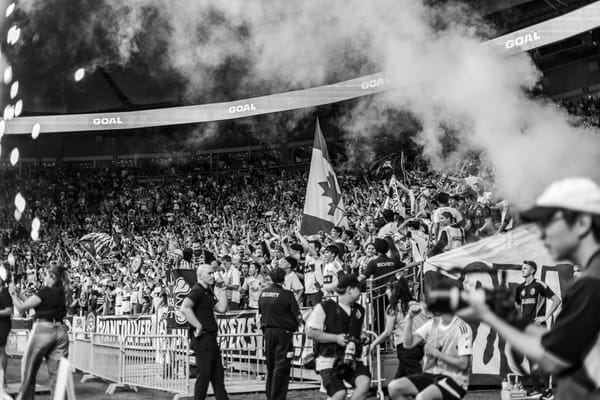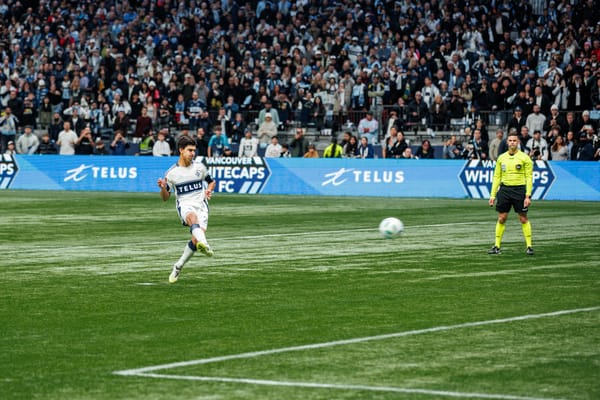Houston Dynamo-Portland Timbers Preview (9/20)
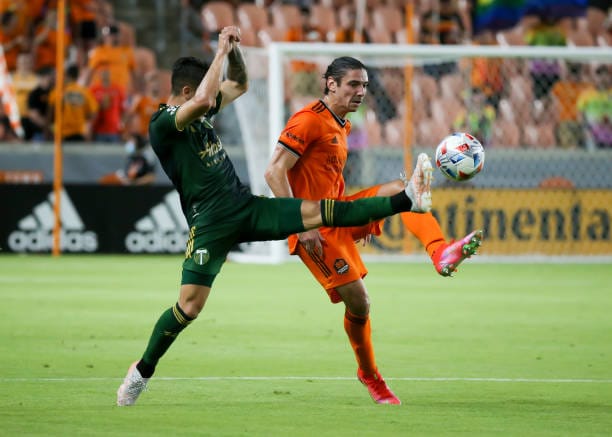
After breaking their 4-game winless streak with a 2-1 win against the New York Red Bulls last weekend, the Portland Timbers are preparing for the final 3-match week of the season. First on the docket is a place where dreams usually go to die: Houston. However, the pressure is very much on the Dynamo ahead of this crucial clash.
The Dynamo Report
On March 30, these two teams met at Providence Park. The Timbers won 3-1, and Houston’s winless start to the season continued. However, it only lasted for another week, as they beat LAFC 1-0 the following weekend.
The post-Hector Herrera Dynamo have largely stuck to the same principles that saw them become one of the toughest teams to beat in the West in 2023 and 2024. However, the talent took a serious hit. Coco Carasquilla, a player that I despise, was the key to Houston’s attack prior to departing in the winter. He was replaced by Jack McGlynn, who has undoubtedly been an upgrade. It’s safe to say that the 22-year-old American has been Houston’s best player in 2025. Top scorer Ezequiel Ponce has a respectable tally of 9 goals. However, he’s fallen short of expectations. The Argentine was Houston’s lone DP at the start of the season, but the winter window saw the addition of Ondrej Lingr.
The Czech forward arrived as a second striker, but he also splits time on the left wing.
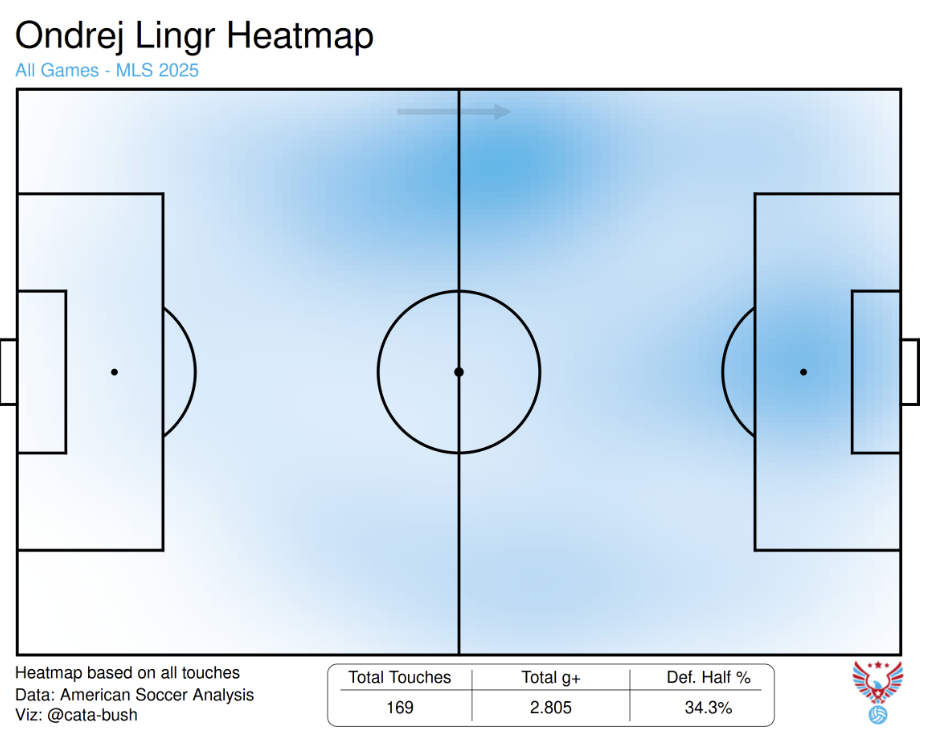
*Quick aside: I’m so happy for the existence of the new American Soccer Analysis Viz Hub. Humongous shoutout to Catalina Bush (@cata-bush.bsky.social) for creating this tool and publishing it for the masses.*
Lingr has been relatively positionless throughout the season. His struggles (3g/3a in 1,544 minutes) speak to the larger theme of Houston’s 2025: mindboggling personnel decisions.
The Dynamo (8-9-13, 33 points, 12W/22S) can be classified as a severely disappointing team. Ben Olsen’s tried-and-true system emphasizes possession as a means of defense. This worked to a high degree of success in 2023, but wasn’t as effective (on the whole) in 2024. I’m not going to talk a lot about Houston’s results. But the evolution of the first-choice squad has been fascinating throughout the season.
Ponce’s role as the starting striker has never been in question. However, Olsen took some time to find McGlynn’s best spot. He became the inverted right winger; a direct replacement for Carasquilla. Lingr split time out wide and at the 10, pushing Amine Bassi to the bench. Herrera was the metronome in midfield, and Bassi was the metronome around the box. However, the Frenchman offered very little goal threat (outside of the penalty spot) so Lingr became the nominal starter in the middle of Houston’s second line. The left wing spot is the site of Olsen’s first major personnel mistake.
Prior to last year, Nelson Quinones’ ACL tear forced Olsen to start Sebastian Kowalczyk on the left wing. Olsen’s system requires the left winger to be an actual winger, and Kowalczyk is a converted striker playing on the wing. However, that changed when Lawrence Ennali arrived at the club in the summer of 2024. The young German hit the ground running and immediately became Houston’s most dangerous ballcarrier; combining elite speed with excellent control. Unfortunately, Ennali tore his ACL a month after joining the club. Kowalczyk began the season as Houston’s nominal left winger (splitting time with Ibrahim Aliyu (another striker-turned-winger) until Aliyu was traded to Columbus in April). Ennali returned at the end of May, but has only started SIX out of the 14 league games he’s appeared in. It’s rather mind-boggling that Ennali (who hasn’t missed a step after that knee injury) is more likely to begin a game on the bench rather than the starting lineup.
Artur and Brooklyn Raines have locked down the midfield spots, but neither offers the same kind of passing range that Herrera had. The Mexican international was a pure 8, while Raines and Artur profile as 6s. So does new arrival Diadie Samassekou. Houston’s backline is somewhat settled. Erik Sviatchenko (when healthy) is still first-choice, and he’s usually partnered with Pablo Ortiz (the replacement for my 2024 Defender of the Year Micael). Felipe Andrade’s loan move from Fluminense was deemed such a success that the club made it permanent four months after the player joined. Griffin Dorsey is still key to Olsen’s system. As the poster boy for the attacking fullback, he often provides the width on the right side while acting as a goal and assist threat. Personnel-wise, Houston has the talent to be a playoff team. However, one of their winter moves might qualify as the dumbest personnel decision of the season across the entire league.
TANGENT: Bond-ed by Stubbornness
I might be stretching the truth a bit. Atlanta’s outpouring of money has brought them ZERO on-field success, but everyone (myself included) was very high on the Five Stripes heading into the season. However, those players were brought in to start and be direct replacements for players that departed in the summer of 2024. It’s very rare to see a signing to replace a player who is doing well. That’s exactly what the Dynamo did when they signed (former West Brom and LA Galaxy) goalkeeper Jonathan Bond.
Houston’s starting goalkeeper in the March 30th game was Blake Gillingham. Steve Clark was not brought back for 2025, so backup Andrew Tarbell and free agent Jimmy Maurer were set to compete for the starting job. Both of them got hurt, so starting duties fell to Gillingham; a free agent signed directly out of Creighton University (shoutout Diego Gutierrez). That March 30th game was Gillingham’s first start, and he was the most impressive Dynamo player on the pitch. Portland could have scored at least five goals in that game, and Gillingham’s next start (a 1-0 shutout win against LAFC) was another display of excellent goalkeeping from the rookie. However, Houston did need to sign a goalkeeper in the wake of Tarbell and Maurer’s injuries. Unfortunately (for the Dynamo), they didn’t view Gillingham as the starting-quality goalkeeper that he obviously is.
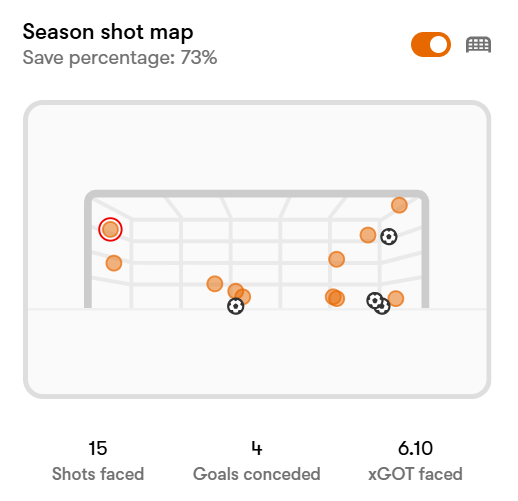
It’s worth noting that Gillingham’s four appearances coincided with Houston’s defense still figuring out their best personnel grouping. Bond arrived on April 11th, and has started every single MLS game since. In that time, he’s been the worst goalkeeper in the league.
Before I delve into the stats (and you know I love to highlight bad stats) it’s worth talking about the salary implications of Bond’s move. Usually I prefer to save these deeper dives for the Timbers, but there’s a clear case to be made that Bond’s elevation and Gillingham’s demotion has cost the Dynamo more than any of their attacking struggles.
Bond’s base 2025 salary is $400K. That’s the same salary as Tarbell and NYCFC goalkeeper Matt Freese (who, at this moment, is the frontrunner to start for the USMNT in next year’s World Cup). Maurer is making half as much as Bond and Tarbell. Gillingham, meanwhile, is on a Reserve Minimum contract ($80K). In total, that’s ONE MILLION DOLLARS allocated to the goalkeeping position. For a team like Houston, who does have other upgradable positions across the roster, that’s insane. There are clubs that are willing to shell out a fair amount of money to goalkeepers (Roman Burki, Andre Blake, Zack Steffen, Pedro Gallese, and Sean Johnson are all making over $1M per year) but it’s a position where finding value is very important to building a strong squad. The best goalkeeper out of these four is the one making $80K. That’s 0.007% of Houston’s total goalkeeper spend. Having two injured goalkeepers usually should necessitate the arrival of a fourth, but that’s when you want to elevate a goalkeeper from your youth team. The signing of Bond was a panic move, and it made Houston’s goalkeeping situation a hell of a lot worse while tying up even more salary space.
That’s just the financial aspect of Bond’s acquisition. Keep in mind that Houston had to pay a transfer fee to bring him from Watford. The fee hasn’t been disclosed, and I’d imagine that the Dynamo are perfectly happy about that. Now we get to Bond’s performance on the field, and we’re going to use one of my favorite stats to illustrate just how disastrous the Englishman has been.
Quick refresher: post-shot expected goal (PSxG) differential measures how good a goalkeeper is at shot-stopping. A chance measured at 0.08 xG, for example, could have a much higher PSxG number because of the quality of the strike. Jonathan Bond has the worst PSxG differential in the league (-7.1). The next-worst goalkeeper is Brad Guzan (-5.4). Guzan has played in 3 more games than Bond. No team has played more than 30 games so far. Among the goalkeepers who have started all 30, John Pulskamp has the worst PSxG differential (-4.8). It’s worth noting that Pulskamp has faced the most combined PSxG (54.2) by a wide margin.
Here’s what Bond’s 2025 season looks like compared to goalkeepers who have played in 22 games or less (Bond has started 22 league games this season):

And here’s how it stacks up when the match limit has been removed:
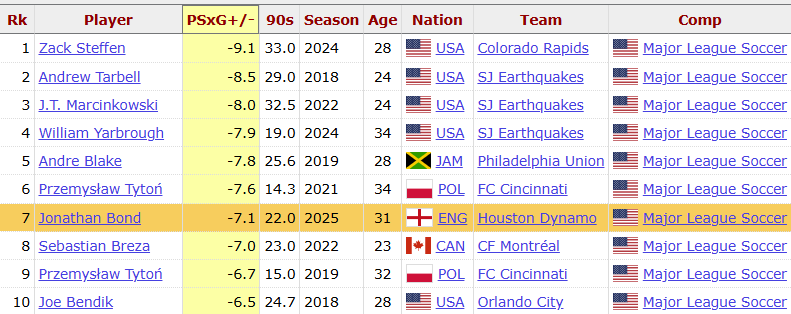
Olsen has stubbornly kept Bond in the starting lineup, despite every single indicator showing that Gillingham is superior. For the record, Gillingham still ranks 18th in this particular stat (+2.1). That’s better than Burki, Joe Willis, and Stefan Frei.
Since Bond’s ascension to the starting role on April 19th, the Dynamo are 7-6-9 (not including a 0-0-3 showing in Leagues Cup). There are a couple quality wins in that stretch, including victories against Minnesota and an away win in San Diego. But some of those losses are dreadful. Two 3-1 defeats at home against Montreal and SKC stand out. That tracks with Houston’s wretched home record. In 15 home games, they’ve collected 15 points (4-3-8). That’s 3 fewer than they have earned on the road. Their goal differential at home is -9, with only 17 of their 39 goals coming at Shell Energy Stadium.
The Dynamo are a very bad home team, but they’re very desperate. Last weekend’s loss in Colorado dropped them to 12th in the West. However, Houston is only 2 points behind 9th-place San Jose. Both teams ahead of them (RSL and Dallas) have a game in hand. Following tomorrow’s game, they play at Nashville and host San Diego. Their Decision Day game is a trip to Children’s Mercy Park. This game is an absolute must-win for Houston. It’s the easiest game remaining on their schedule aside from the finale, which could be played with the Dynamo already eliminated. Tomorrow is the most important game of their season.
HOU Injury Report & Projected Starting XI
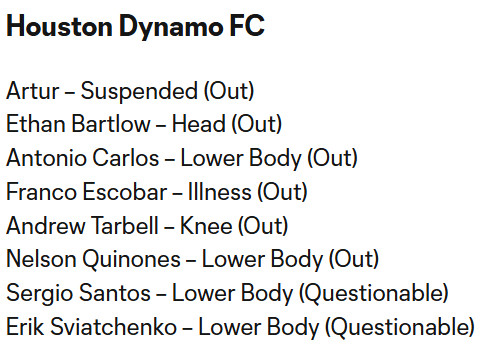
The Dynamo will have to play tomorrow’s match without head coach Ben Olsen on the sidelines due to a yellow card accumulation suspension. However, based on recent events involving suspended coaches, he’ll still be involved in game-planning and even in-game adjustments. The headliner on this lengthy report is Artur. Franco Escobar scored the only Dynamo goal in the March 30th game. Antonio Carlos and Sergio Santos joined in the summer. I’m counting four center backs on this report (which includes Escobar).
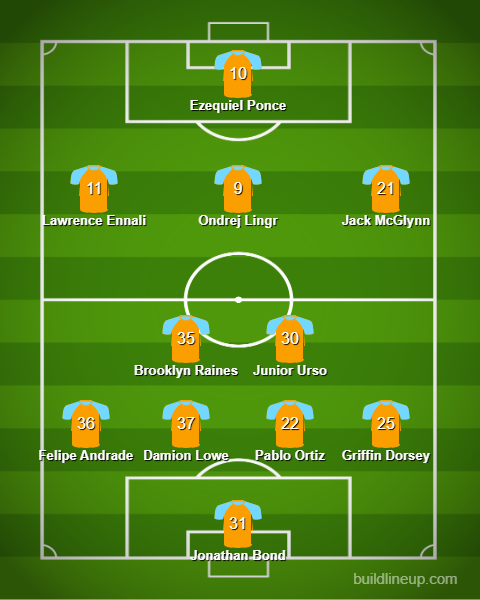
None of those absences affect the front four. The logical choice for Artur’s replacement is 36-year-old Junior Urso. However, the Dynamo did sign Diadie Samassekou on a free from Hoffenheim this summer. He hasn’t made a matchday squad yet, but could be in play for tomorrow’s season-deciding clash. The fullbacks are settled, and Bond should still be between the sticks. Houston loaded up on center backs during the summer, so the injury report will probably force them to give Lowe his Dynamo debut. Ortiz will definitely start, but Lowe’s spot could be taken by rookie Femi Awodesu. Houston does not have a midweek game to plan for. They have to go with their best available XI.
The Timbers Report
It feels good to win a game of soccer. That win turned Portland’s 4-game winless streak into a 3-game unbeaten streak. Three points are very powerful, I guess.
The Timbers (11-9-9, 42 points, 6W/15S) haven’t lost in 3 of their last 4 road games. A draw in Minnesota, a draw in San Diego, a loss in Dallas, and a win in LA. They get results against the good teams and fail to beat the poor teams. Tomorrow’s game in Houston falls into the latter category, and the added difficulty of Texas puts another layer on a difficult cake. Tack on Houston’s desperation as well for extra flavor.
Velde’s First Impressions
The Kristoffer Velde experience has been in effect for three games. So let’s take a look at the data to see how he’s been able to affect Portland’s play thus far.
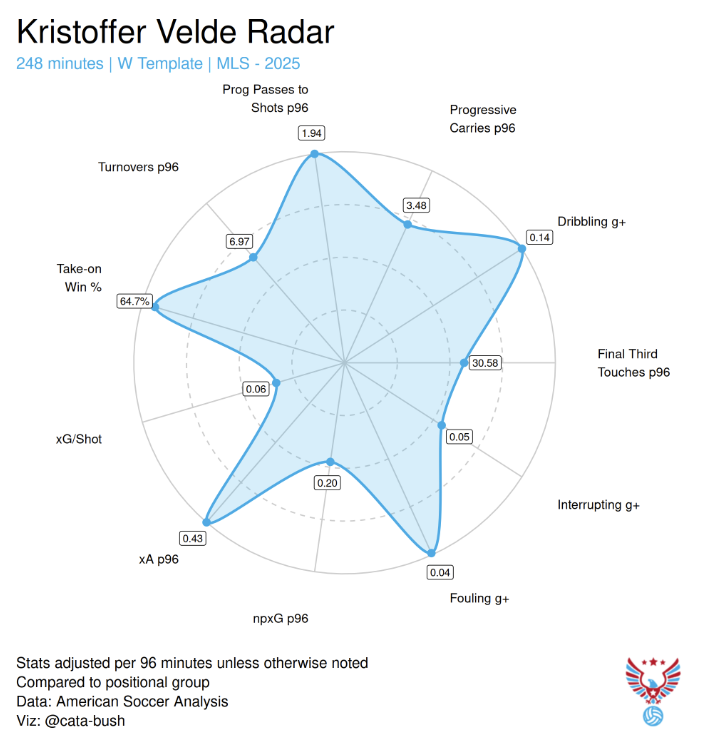
There’s a lot of good stuff here. Chief among them is his outstanding dribbling. The Minnesota game showed his ability to draw fouls. I’m also pleased to see how good his progression has been. Do I think these numbers are going to hold firm throughout the rest of the season? I’m not too sure about that. These are stats that you’d expect to see from a number 10. It makes sense considering his last two starts have come at that position. So what will change when David Da Costa returns?
I expect two of these statistics to jump up. One of the main traits Velde showed on his Poznan and Olympiacos tape was his shooting ability. Based on his disallowed goal against New York, he knows how to get himself into dangerous spots. The npxG/96 and xG/shot numbers should go through the roof with a primary creator in the team.
Either way, it’s been a very strong start for Velde. The goals and assists are sure to follow. He passes the eye test and the underlying numbers are very promising.
Roster Profile!
On Friday morning, the final roster profiles of the season were released.
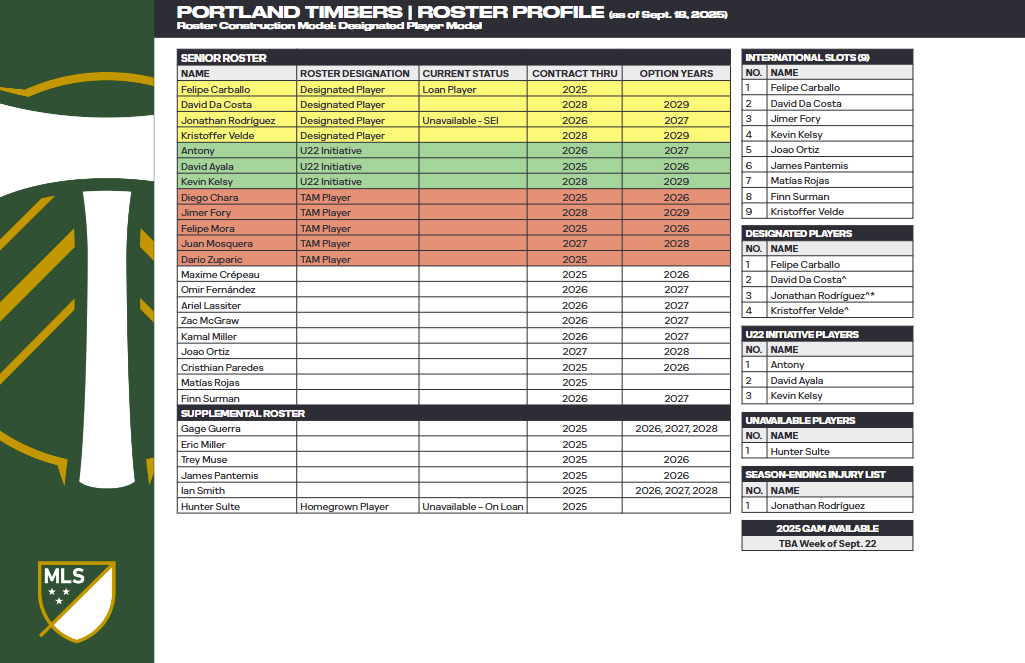
Nothing has changed aside from the addition of the Summer Three. Let’s begin with Felipe Carballo. He’s still listed as a DP, which makes even more sense following his ACL tear. Because Jonathan Rodriguez is already occupying a SEI slot as a DP, Carballo cannot use an SEI tag. Velde will hit the cap as a DP. You already knew that. The lone wild card was Rojas. His salary is still unknown, but the Timbers are not using any TAM to fit him into the salary cap. Like I previously discussed with Joao Ortiz, this doesn’t preclude him from having a large salary or a large raw cap hit. Portland’s available GAM will be released next week.
PTFC Injury Report & Projected Starting XI
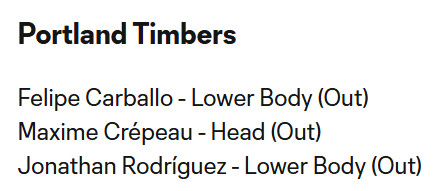
Portland’s report is copy-pasted from last weekend.
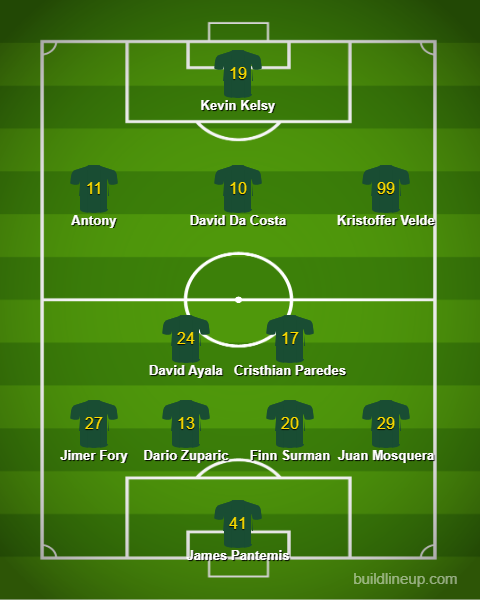
This lineup largely picks itself, but the busy week is probably going to have some minutes restrictions attached. Chief among those “restricted” players is Mosquera. Da Costa has to start tomorrow. I’m leaning towards Paredes due to his ability to break up play and disrupt. It’s also worth noting that his best performances this season have come on the road. Portland still has depth on the bench, but their primary aim should be to start strong despite the looming trip to Vancouver on Wednesday. Dario Zuparic, meanwhile, has to start again. “When I’m playing, it’s the best back line,” the Croatian told reporters on Thursday. I’m not going to disagree with him.
Tactical Preview
Control
Houston and Portland have similar philosophies: control the ball and control the game. However, their main avenues for box penetration are very different. The Dynamo want to pass the ball into the box while the Timbers prefer to carry it. However, Portland’s passing numbers are actually pretty good!
Houston is a short-passing team. Portland’s main strength is medium-range (15-30 yards). I expect the Dynamo to dominate the ball tomorrow. That’s not a bad thing for the Timbers.
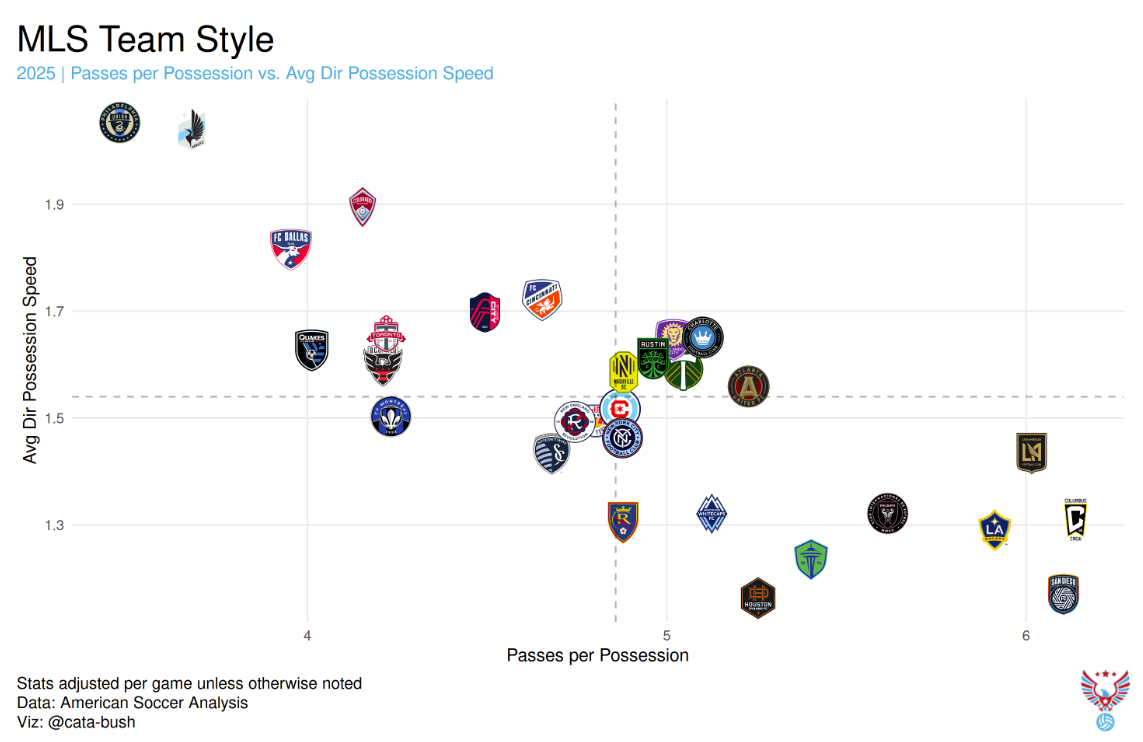
These stats take the entire season into account. Portland is clustered in the middle of the pack, but there’s been an improvement since the arrival of the Summer Three. Over the past three games, they’ve been moving slightly towards the top left of the graph. Like they did against Minnesota, the Timbers should be able to find success by absorbing pressure and counterattacking into space.
Left Wing vs. Right Back
Two very similar battles will take place on opposite sides of the field. Portland and Houston have right backs that are encouraged to get forward and affect play around the box. Meanwhile, each team has a left winger that is lightning-fast and primed to attack the space vacated by the right backs’ repeated voyages up the pitch. However, the Timbers do have an ace-in-the-hole: Finn Surman. Ennali has drawn some Denis Bouanga comparisons (I kinda see the vision, but that’s a step too far at Ennali’s current playing ability) and Surman has made his name this season by locking up rapid wingers on his side of the pitch. On paper, the Timbers have the advantage in this mini chess match.
Rotation
Phil Neville has to make some tough decisions in regards to this week. How do you weigh this Houston game with the upcoming Cascadia Cup decider in Vancouver? “I think we’ve managed these players really well. I think they’re going into these games full of energy. And I think what we’re really asking them to do is play three 90-minute games in a seven-day period. At this stage of the season, fatigue goes out the window.”
That’s what Neville said on Thursday. There is a chance that the Timbers begin tomorrow’s game with a “weaker” lineup with the intention of reaching halftime in a good position to fully take over in the second half. But I don’t think that tracks with Neville’s principles. He wants to dominate, especially against a weaker opponent. There will be some rotation, yes, but not a significant amount of changes.
Matchday Info
Announcer Analytics
English: Neil Sika & Lloyd Sam
Spanish: Jose Bauz & Ivan Kasanzew
Home radio broadcast from 750 The Game: not available on Apple TV
Broadcast platform: Apple TV
Kickoff time: 5:30 PM PST
Referee Report
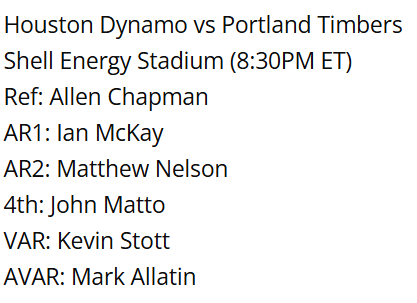
Allen Chapman’s 2025 stats: 22 games, 21.05 fouls/game, 0.41 penalties/game, 2.86 yellows/game, 0.09 reds/game
Last Timbers game officiated: May 12, 2024 vs. SEA 2-1 L
Quick note: Chapman’s record of 2.86 yellow cards per game is the lowest amongst MLS referees who have officiated at least one game.
Series History
Historical record: 11-9-9, 0 goal differential
Road record: 1-7-6, -12 goal differential
Current streak: 1 win
Current road streak: 2 losses (3 winless)
Table Time
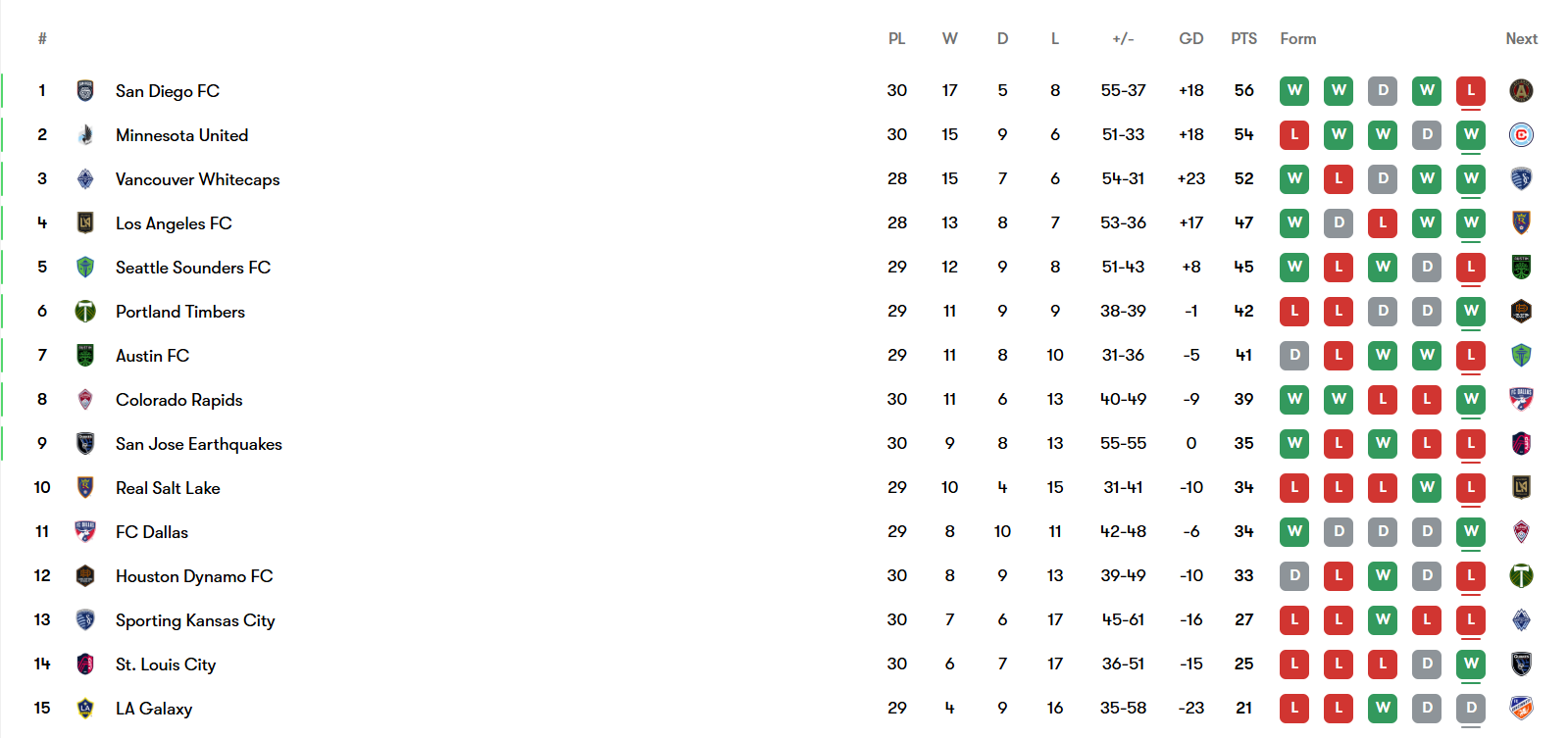
I’ve already laid out the stakes for the Dynamo. With a win and some help from Austin FC, the Timbers could jump into 5th place. However, a loss could drop them to a provisional 8th. Austin hosts Seattle, and Timbers fans will probably be rooting for the Broccolis to hand the Sounders an L. But that could come at Portland’s expense if they don’t beat Houston. This is the last week that the Timbers will have a game in hand. They’re the only “Rest of the Pack” Western Conference team that plays a midweek game. Austin’s game in hand won’t be settled until the week before Decision Day. Portland’s main goal of “avoid the Wild Card” is still on track. But this is a game that they have to win to keep that pace.
Final Whistle
I don’t consider Portland-Houston a rivalry. But the Dynamo have a habit of ruining Timber seasons.
When the question of the greatest Timbers team gets raised, the answers can be all over the map. However, there are five squads that could lay claim to that crown: 2013, 2015, 2017, 2019, and 2020. An argument could be made for a 2024 team that played their best possible XI at every opportunity as well (based on talent). 2013 was the first great Timbers team, and the season ended in heartbreak in the Western Conference Final. 2015 ended with the Cup. Enough said. 2019 is the biggest “what if?” season in Timbers history. 2020 is another contender for that crown. But the 2017 Timbers were the true team of destiny. And the Houston Dynamo ended their season.
The first culprit is boiling water. Sebastian Blanco sustained second-degree burns after pouring boiling water on himself while cooking in the week before the first leg of the 2017 Western Conference Semifinal. The Timbers finished the regular season on top of the Western Conference. The path to MLS Cup ran through the Rose City. Until Blanco’s mishap caused him to miss the first leg; a trip to Houston. Maybe the Dynamo had something to do with it, but it’s clearly a case of horrific luck.
But that wasn’t the only disaster to occur during this series. I’m going to level with everybody here: the grass vs. turf debate is very stupid. What matters most is the quality of the playing surface. A bad grass field is much worse than an excellent turf field. On that fateful October night in Houston, a bad grass field claimed Diego Chara. His broken foot completely shifted the tide of the series, and threw Portland’s MLS Cup hopes into jeopardy. The best squad in Timbers history was sent home (at home) by a middling Dynamo team.
2023 is the only other season where the Dynamo haunted Portland. A 5-0 loss at Shell Energy Stadium was the last game that Giovanni Savarese ever coached for the Timbers. After his firing, interim head coach Miles Joseph managed to get the team back into playoff contention ahead of a Decision Day showdown with Houston at Providence Park. Once again, the Dynamo sent Portland home at home.
This is the 50th year of Timbers soccer. The eternal Texas foes of Houston and Dallas (not you Austin, you don’t count) await the Timbers every year in their hellhole of a state to send them back to the Pacific Northwest without a victory. It’s basically a foregone conclusion. Except when it isn’t.
In 2018, the Timbers traveled to Dallas on Halloween for a playoff game. For the second time ever, they won. They haven’t won a game in Dallas since. Many people point to the 2-0 win in Seattle as the turning point of Portland’s 2021 season. On the surface, it’s completely logical. But they traveled to Houston five days after vanquishing their rivals at Lumen and got their only win in H-Town to date. That was the second game of an 8-game unbeaten streak (only one draw) that propelled them back into playoff contention (and, by extension, a MLS Cup appearance).
Since 2021, the Timbers have been fighting for their lives in September. They’ve needed every single point in order to keep their playoff dreams alive. In 2025, that ball is in Houston’s court. Portland has an opportunity tomorrow. They can keep their dreams of a top-four spot alive while crushing a hated pest’s playoff hopes in one fell swoop. There is no such thing as a trap game in Houston. Portland’s history in Space City is dreadful. But it’s the Timbers who enter this match with momentum. And they have to capitalize, for their own hopes and for the sake of schadenfreude. The climb continues.

